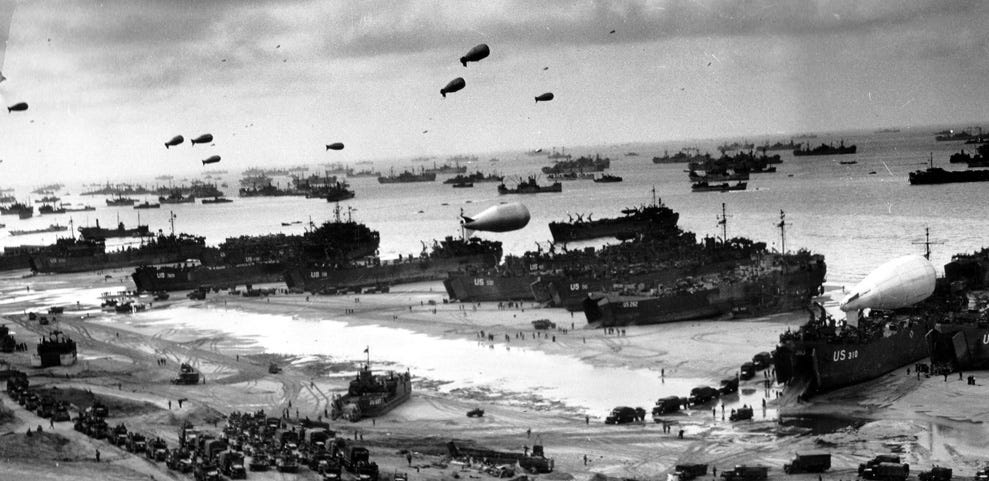On this day in 1942, Japanese Admiral Chuichi Nagumo, commander of the fleet that attacked Pearl Harbor, launches a raid on Midway Island with almost the entirety of the Japanese navy.




As part of a strategy to widen its sphere of influence and conquest, the Japanese set their sights on an island group in the central Pacific, Midway, as well as the Aleutians, off the coast of Alaska. They were also hoping to draw the badly wounded U.S. navy into a battle, determined to finish it off.



The American naval forces were depleted: The damaged carrier Yorktown had to be repaired in a mere three days, to be used along with the Enterprise and Hornet, all that was left in the way of aircraft carriers after the bombing at Pearl Harbor.



On the morning of June 4, Admiral Nagumo launched his first strike with 108 aircraft, and did significant damage to U.S. installations at Midway. The Americans struck back time and again at Japanese ships, but accomplished little real damage, losing 65 of their own aircraft in their initial attempts. But Nagumo underestimated the tenacity of both Admiral Chester Nimitz and Admiral Raymond Spruance, commanders of the American forces. He also miscalculated tactically by ordering a second wave of bombers to finish off what he thought was only a remnant of American resistance (the U.S. forces had been able to conceal their position because of reconnaissance that anticipated the Midway strike) before his first wave had sufficient opportunity to rearm.



A fifth major engagement by 55 U.S. dive-bombers took full advantage of Nagumo's confused strategy, and sunk three of the four Japanese carriers, all cluttered with aircraft and fuel trying to launch another attack against what they now realized—too late—was a much larger American naval force than expected. A fourth Japanese carrier, the Hiryu was crippled, but not before its aircraft finished off the noble American Yorktown.


The attack on Midway was an unmitigated disaster for the Japanese, resulting in the loss of 322 aircraft and 3,500 men. They were forced to withdraw from the area before attempting even a landing on the island they sought to conquer.



Taken from: http://www.history.com/this-day-in-history/the-battle-of-midway-begins [04.06.2014]
As part of a strategy to widen its sphere of influence and conquest, the Japanese set their sights on an island group in the central Pacific, Midway, as well as the Aleutians, off the coast of Alaska. They were also hoping to draw the badly wounded U.S. navy into a battle, determined to finish it off.
The American naval forces were depleted: The damaged carrier Yorktown had to be repaired in a mere three days, to be used along with the Enterprise and Hornet, all that was left in the way of aircraft carriers after the bombing at Pearl Harbor.
On the morning of June 4, Admiral Nagumo launched his first strike with 108 aircraft, and did significant damage to U.S. installations at Midway. The Americans struck back time and again at Japanese ships, but accomplished little real damage, losing 65 of their own aircraft in their initial attempts. But Nagumo underestimated the tenacity of both Admiral Chester Nimitz and Admiral Raymond Spruance, commanders of the American forces. He also miscalculated tactically by ordering a second wave of bombers to finish off what he thought was only a remnant of American resistance (the U.S. forces had been able to conceal their position because of reconnaissance that anticipated the Midway strike) before his first wave had sufficient opportunity to rearm.

A fifth major engagement by 55 U.S. dive-bombers took full advantage of Nagumo's confused strategy, and sunk three of the four Japanese carriers, all cluttered with aircraft and fuel trying to launch another attack against what they now realized—too late—was a much larger American naval force than expected. A fourth Japanese carrier, the Hiryu was crippled, but not before its aircraft finished off the noble American Yorktown.
The attack on Midway was an unmitigated disaster for the Japanese, resulting in the loss of 322 aircraft and 3,500 men. They were forced to withdraw from the area before attempting even a landing on the island they sought to conquer.
Taken from: http://www.history.com/this-day-in-history/the-battle-of-midway-begins [04.06.2014]

